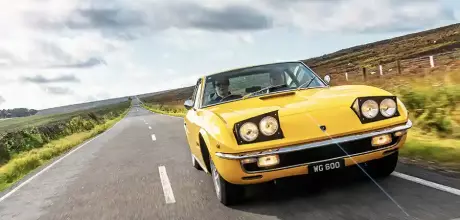1969 Lamborghini Islero 400 S
The List Reader Stephen Marshall steps into a Roger Moore-style Lamborghini Islero. From a list filled with movie and TV show star cars, will Stephen Marshall’s ultimate choice of the Lamborghini Islero 400 S haunt him for ever, or produce a special bond?
Words NATHAN CHADWICK
Photography JONATHAN JACOB
‘It’s a proper Jekyll and Hyde character’
Lamborghini Islero: the car that haunted CC reader Stephen Marshall
Even the peacocks feel outdone. The Peak District’s Strines Inn is no stranger to extravagant birds, but as Roger Wood’s Lamborghini Islero S rumbles into view, there’s no doubt who rules the roost.
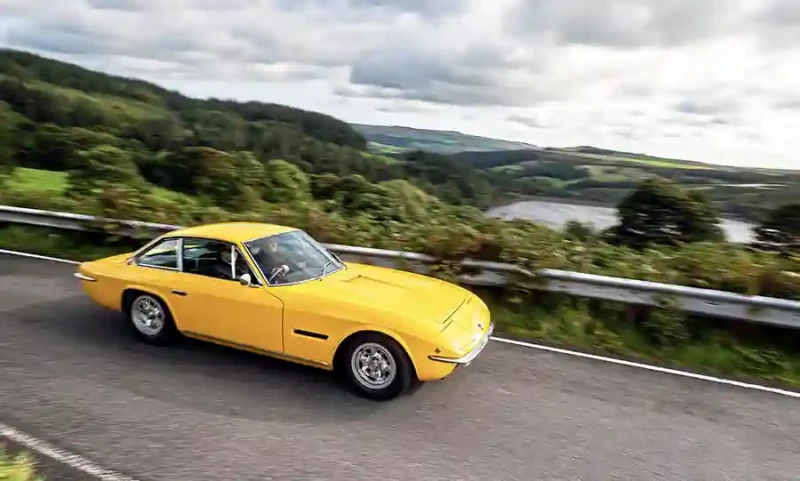
This month’s lucky List driver is Stephen Marshall, an Australian perceived-quality (craftsmanship) manager who’s been living and working in the UK since 2016, and was until recently part of the team that ensured the Lotus Emira’s design execution is, well, less traditionally Lotus-like and somewhere you’d actually want to spend time in most days, and not just when testing the bounds of mid-corner physics.
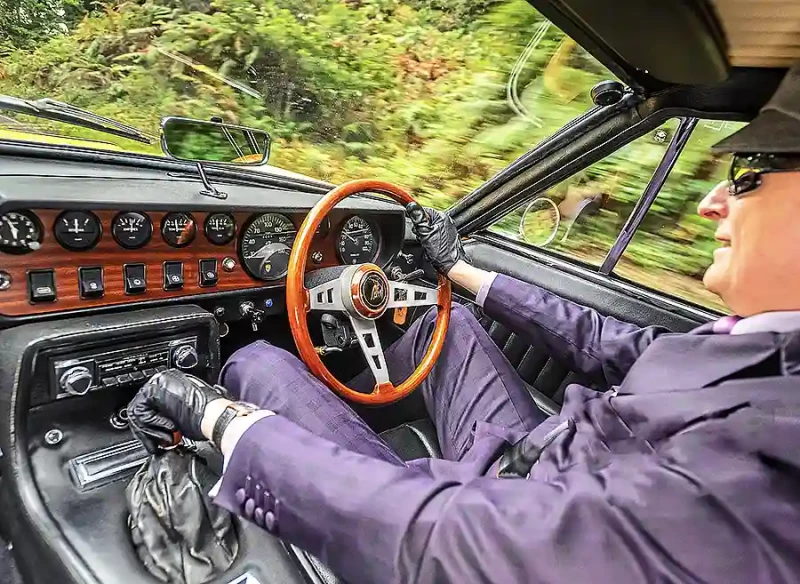
His dream drive list is stacked to the brim with cars made famous by movies and TV shows. ‘I fairly jokingly said in my submission that as someone who works in the car industry and who is passionate about movies as owning classic cars, I believe there’s a very good chance I was conceived at the drive-in.’ The Islero is here because of its showstopping appearance in the 1970 Roger Moore film The Man Who Haunted Himself. ‘Roger Moore's character left a lasting impression of the Islero being a jet-set cad's car,’ Stephen says. ‘Unlike its period sister car, the Miura, my 187cm [6ft 2in] frame has a chance of fitting in one.’ For Stephen, it plays into his love of a particular era. ‘It's part of that evocative, late-Sixties, early-Seventies period where things were more flamboyant,’ he explains. ‘Things aren’t as staid as the early Sixties, but not quite in the fully flared Seventies period. It's a weird time of transition stylistically – I just love that period.’ He’s suitably enamoured with Roger Wood’s Islero. ‘It looks like it’s come straight from the showroom – it’s obviously been well looked after and well restored. It has all these wonderful chrome details, the sort of thing that often companies put in now to make a car feel premium, but back then the hardware they used was more mechanical and tended not to be all plastic.’
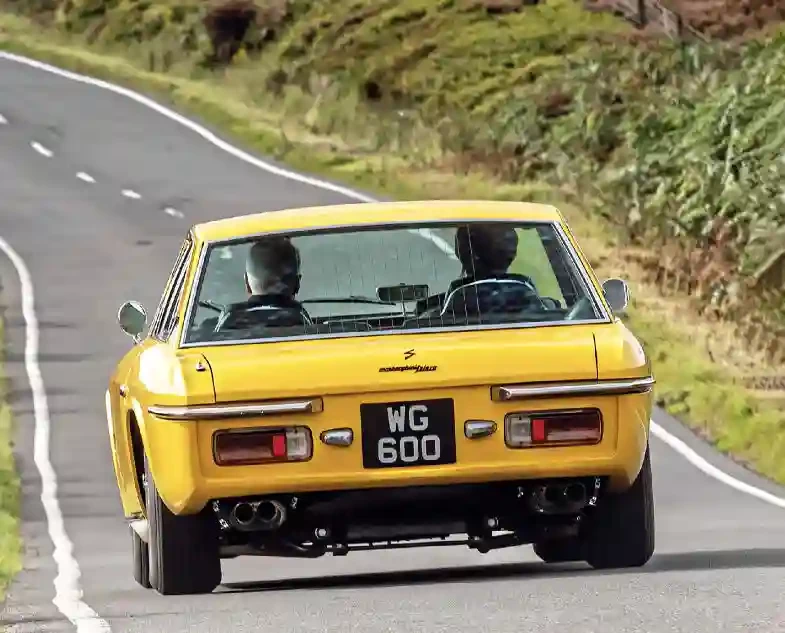
The stand-out – or should we say, pop-up – element of the exterior design has to be the lights, according to Stephen, who has owned five cars with this feature. ‘It’s really striking, because this car comes from an era when pop-up headlamps were still a novelty, even though Cord had done it back in the Thirties,’ he says. ‘They give the car such a presence on the road – when you consider that the top-selling car in the UK at the time was the Morris-Austin 1100/1300, this must have seemed like a spaceship.’ Of course, seeing an Islero at all would be an extremely rare occurrence. Of the 225 built, it’s believed that just five were right-hand drive, and two – including this one – came to the UK. Given such rarity, Stephen’s taking his time absorbing all the Islero’s details, including the fake exhaust grilles on the front wings. ‘I see this as a very transitional design between the more curvy and voluptuous stuff that had come before, and the more extreme wedgy stuff that came in the Seventies proper,’ he says. ‘It’s got some beautiful curvature with the way the nose comes down with the headlamps, but you’ve got straight lines elsewhere and pronounced creases in the bodywork as well.’ While Stephen and I could stare at the Islero’s form for hours, the Derbyshire drizzle is threatening to become a downpour.
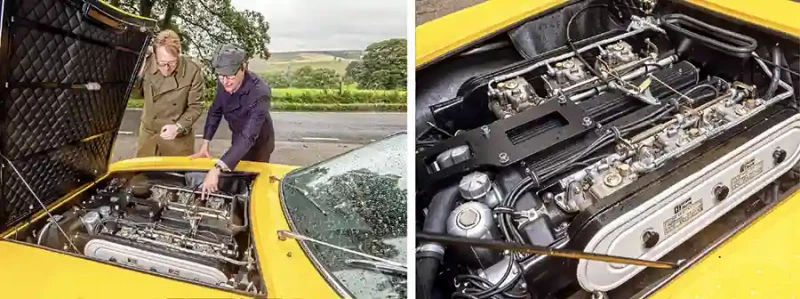
Stephen pops open the elegant door and drinks in the atmosphere. However, as an industrial designer, his eye is caught by something rather more practical than you may imagine. ‘It has a light in the door as a warning for vehicles behind you, which a lot of cars didn’t have back then – the only other car I can remember from that time that had it was the Triumph Stag.’ Next, Stephen finds himself enraptured by the wood-rimmed alloy steering wheel. ‘As a designer, I couldn’t help but notice how beautifully crafted that is,’ he muses. ‘Instead of having circular holes like you’d have in a traditional Sixties steering wheel, it’s got rectangular slots that have clearly been designed – Lamborghini was always very forward-looking, almost futuristic with its approach to styling.’
‘It’s a very visceral experience that a modern car simply wouldn’t give you’
In spite of this, the Islero was deemed to be the conservatively minded foil to the concurrent Espada, something that Stephen believes confers benefits with regards to useability. ‘It has fairly upright glazing; it doesn’t have a really fast sweep to the front or rear screen,’ he says. ‘That provides almost 360º vision – there are so many sports GT cars with an extreme sloping rear. Even on an Aston DBS or Vantage, the rear window line means that from the inside you’re kind of peering through a slot, whereas on this car, any direction you look in, you’ve got very thin pillars.’

However, a glance across the Jaeger dials brings back strong memories of his first classic, a third-gen Fiat 124 Coupé. That purchase was informed by none other than Classic Cars magazine. ‘Even though the gauges are Jaeger, not Veglia like those in my old 124, it’s almost the same set-up. Underneath those dials it had similar Italian-style rocker switches – and the Islero feels like a 124 Coupé with everything turned up to 11,’ he says. ‘All the instruments are very clear, it’s not like some Italian cars of the era, where it feels like someone has loaded a shotgun with switchgear and blasted them at the dashboard.’
Stephen gets behind the wheel. ‘I’m 6ft 2in, all legs and normal body size, but I find myself… proportionally challenged.’
This has something to do with owner Roger Wood raising the seat height during the extensive restoration. ‘It’s a fairly typical Italian driving position,’ he confirms. ‘I’ve got one knee against the door pull and armrest, and one against the centre console, and the wheel is fairly low – it’s not completely uncomfortable because I’ve driven Italian cars before, but there is a sense it wasn’t really designed for someone of my proportions.’
Any problems with the driving position are swept away when the 4.0-litre V12 thundercracks into life, and away we go on to the Strines Pass. ‘Even though it doesn’t have power steering, it’s only heavy at low speeds,’ says Stephen.
The gearbox is the biggest surprise. ‘There’s no difficulty with the synchromesh, and the gate is precise – it’s not like some GT cars I’ve driven, such as transaxle Alfas, where you’ve got this ridiculously vague gearshift. There’s no trouble slipping through the ratios, though it does seem a bit under-geared in the sense that at fairly moderate speeds, it feels like I’m in a lower gear than I’m actually in. It’s as if every gear is there to get the maximum performance out of the engine, even though it’s a GT car.’
As the bends straighten out, Stephen’s foot explores the deeper realms of the Islero’s pedal travel. ‘It sounds amazing! There’s a fantastic induction noise from the carburettors, and the exhaust – it’s an absolute joy to guide around swiftly.’
Of course, big GT cars of the era usually have clutches as heavy as the fuel bill, but though noticeably weightier than Stephen’s 944 Turbo, the Islero is amenable. ‘My knee position should be making it awkward, but it’s not noticeable once you’re used to it.’ The Strines Pass is tight in places, with plenty of opportunities to delve further into the Islero’s steering capabilities. ‘There's an initial vagueness and wobble, where if you move it slightly, nothing really happens with the road wheels, but once you start actually turning, it feels very precise,’ Stephen says. ‘Going through corners, I don’t have to put on a lot of lock – it’s literally just guiding it through. I’m used to driving cars without power steering, so it’s not difficult to adjust.’ The ease of use continues with the engine. ‘At low speeds it’s really docile – with six massive Weber carbs, I wouldn’t have been surprised if it coughed and sputtered going from idle to driving speed, but it’s very smooth – there’s no hesitation. The whole driveline feels very well sorted. It’s an easy car to drive when yougo from a fairly moderate throttle pedal to putting the boot in.’ The Islero was one of Ferruccio Lamborghini’s favourite cars, and he played a far more in-depth role in its development than others in the factory stable. Stephen can easily see why.
‘At fairly low engine speeds, there’s a quietness to it. But then…’ – fortuitously, a straight section opens up and the V12 roars into life – ‘you are unleashing this tiger! The engine comes alive, the exhaust and induction noises fill the cabin. It’s only then intrusive but, given the type of car, it’s not out of step. It’s a proper Jekyll and Hyde character – it’s a fantastic, raw feeling even at fairly moderate speeds. Unlike a lot of older cars, which don’t actually feel particularly quick despite their performance stats, this one would still give an experience that excites against the clock if you were using that full performance potential.’ Stephen admits that modern cars would be much quicker, but that’s not the point. ‘It's not just what's happening on the speedo – it’s a sound and vibration, a very visceral experience that a modern car simply wouldn't give you.’
Sadly, as the skies darken above Dale Dike reservoir it’s time to head back to the Strines Inn for a debrief. Stephen is, understandably, smitten. ‘I think this car is one of the great unsung supercars of the late Sixties,’ he says. ‘The conservative styling and the fact that Lamborghini made so few mean that a lot of people just don't know what it is.’
As we finish our stout cups of tea and get ready to part ways, Stephen has some final thoughts. ‘Unlike so many other supercar GT cars of the late Sixties and early Seventies, its performance is accessible and remains impressive,’ he enthuses. ‘It's still something that’ll make you smile and even though you wouldn't necessarily push it to extremes because it’s a classic car, it's never going to feel slow. It deserves a higher profile.’ Thanks to Roger Wood for the loan of the car, and to Felicity Rattray at Thorough Events.
TECHNICAL DATA 1969 Lamborghini Islero 400 S
- Engine 3929cc V12, DOHC, 6 Weber 40 DCOE 20-21 carburettors
- Max Power 345bhp @ 7500rpm
- Max Torque 290lb ft @ 5500rpm
- Transmission Five-speed manual, rear-wheel drive
- Steering Unassisted ZF worm & roller
- Suspension Front: independent, wishbones, coil springs, anti-roll bar, telescopic dampers. Rear: independent, wishbones, coil springs, anti-roll bar, telescopic dampers
- Brakes Servo-assisted Girling discs front and rear
- Performance Top speed: 162mph
- Acceleration 0-60mph: 6.2sec
- Weight 1460kg (3219lb)
- Fuel consumption 15mpg
- Cost new £6468 (est)
- Classic Cars Price Guide £135,000-£235,000
Our writer (left) and Stephen contemplate a high-carb diet
Borletti aircon was fitted to period Ferraris too.
Clear, logical dash layout impresses Stephen The needle is capable of moving past that 160…


